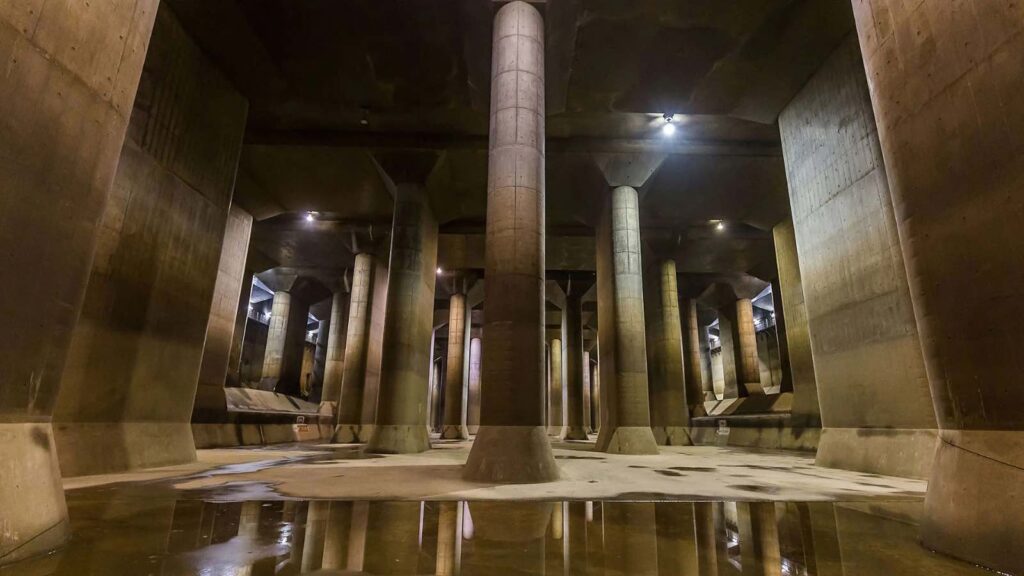As climate change fuels deadly downpours, Tokyo ramps up flood protection.
Beneath the bustling streets of Tokyo, an enormous tunnel is being carved out to guard the city against one of the most dangerous threats it faces: flooding. This is no ordinary infrastructure project. With a width of over 13 meters, a tunnel boring machine steadily advances, laying down concrete walls as it burrows its way through 4.5 kilometers of earth, preparing to handle massive amounts of rainwater that would otherwise flood the homes above.
RELEVANT SUSTAINABLE GOALS



Japan has long had an extensive system of tunnels, drainage channels, and water storage facilities. But as the world grapples with unprecedented climate events, even Tokyo, a city that prides itself on innovation and preparedness, must expand its defenses. The summer of 2024 was the hottest Japan had seen since records began in 1898, and the country’s weather agency warns that the trend shows no signs of stopping. In Tokyo, fierce, sudden storms—aptly dubbed “guerrilla downpours”—are becoming more frequent.
“We anticipate that by 2050, with global temperatures rising by 2 degrees Celsius, rainfall could increase by 1.1 times,” says Shun Otomo, a construction manager for Tokyo’s Metropolitan Construction Bureau. “As climate change intensifies, these types of storms are expected to happen more frequently, and the impacts will be broader. That’s why we are reinforcing our facilities to ensure the safety and security of Tokyo’s residents.”
A Giant Underground Cathedral to Capture and Drain Floodwaters
Tokyo’s latest flood prevention structure is nothing short of colossal. Designed to hold nearly as much water as 100 Olympic-sized swimming pools, this vast tunnel system, featuring towering 18-meter-high stone pillars, provides a crucial buffer against rising water levels in nearby rivers. When rivers overflow, their waters are funneled through a 6.3-kilometer underground tunnel into what is formally known as the Metropolitan Outer Area Underground Discharge Channel—though many call it the “Underground Shrine.”
Inside this “cathedral,” 59 gigantic columns, each weighing 500 tons, rise from the ground, their sheer size dwarfing anyone who ventures inside. These columns support the massive structure as it redirects floodwaters into Tokyo’s Edogawa River. The system is powered by four of Japan’s largest water pumps, which are capable of moving 50 cubic meters of water per second, preventing potentially catastrophic floods from submerging the city.
Tokyo’s Expanding Battle Against Climate Change
Tokyo’s extensive flood control measures reflect a harsh reality: Japan faces twice the global average rainfall, making flood prevention crucial in a country where dense urban populations are concentrated in vulnerable areas like Tokyo. With the increasing severity of storms linked to climate change, Japan’s flood infrastructure has had to evolve in both size and sophistication.
The summer of 2024, with its record-breaking heat, served as a stark reminder of how urgent the climate crisis has become. For Tokyo, the stakes are high: extreme storms could cripple the city, causing not just water damage but devastating losses in infrastructure and human life. As the planet warms, experts predict storms will become more erratic, making it even harder to anticipate and manage potential flooding.
But Tokyo isn’t just preparing for today’s storms. The massive tunnels and underground reservoirs are designed with the future in mind. “Our goal is to ensure that Tokyo can withstand the kind of intense weather patterns we expect to see more of as the climate continues to change,” says Otomo.
A Modern Marvel: How Tokyo’s Underground Shrine Came to Be
The construction of Tokyo’s flood control systems is an engineering feat. The tunnel boring machine, with a diameter of more than 13 meters, works tirelessly, cutting through the earth and laying concrete walls as it goes. This machinery allows the tunnel to gradually form while reinforcing the structure, ensuring it remains stable even as tons of earth are displaced.
The scale of the project is hard to comprehend. The first part of the flood management system was constructed beneath Route 16, a beltway in the Tokyo Metropolitan Area. The system’s main pressure-adjusting tank—the “Underground Shrine”—is large enough to hold the Statue of Liberty, a testament to the engineering prowess that went into its creation.
The facility is built to accommodate overflow from small and medium-sized rivers, channeling excess water into its enormous shafts, which measure 30 meters in diameter and 70 meters deep. From there, water is directed through a 6.3-kilometer underground tunnel toward the shrine, where it is then pumped into the Edogawa River, far from Tokyo’s urban core.
As storms become more unpredictable, Tokyo is taking bold steps to safeguard its future. The creation of vast flood tunnels and underground reservoirs is part of a larger strategy to combat climate change in real-time. These initiatives not only protect the city’s infrastructure but also provide a glimpse into how urban centers worldwide must adapt to a rapidly changing planet.
Lead image courtesy of Getty Images
You may also be interested in :
Transforming Seoul’s Banjiha: A Blueprint For Resilient Housing In A Changing Climate




